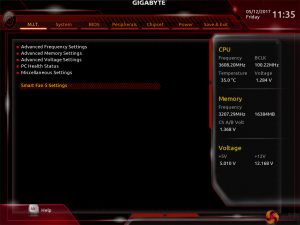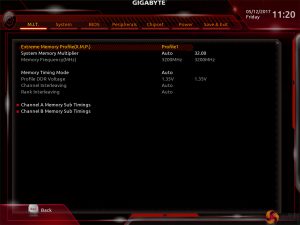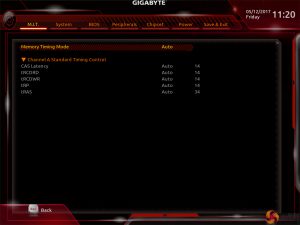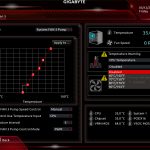Gigabyte B350 UEFI
The UEFI used by Gigabyte is almost identical across its current product range. As such, we have re-used the bulk of our analysis from previous reviews and updated the text where there are subtle differences.
Firstly, we are pleased to report that our generic wireless mouse worked correctly in the Gigabyte UEFI. Some mice can be troubling with UEFI support, so when a generic wireless unit functions correctly in the interface, that is usually a good sign for overall mouse support.
Gigabyte’s Easy Mode page is a solid attempt at categorising a handful of simple settings into a single section. Users can alter the boot sequence, check fan speeds, monitor temperatures and voltages, enable XMP, and change the performance mode without jumping into the deeper (and scarier for less experienced users) UEFI sections.
I don’t have any complaints about Gigabyte’s Easy Mode implementation. It is as good as the versions used by competing vendors.
M.I.T. is the main section where parameters relating to voltages, frequencies, and power settings for the system’s main components are found. The Memory and Voltage sections are split from the Frequency subsection, which makes sense until one realises that an entire group of memory settings is replicated in both the Frequency and Memory subsections.
The subsection splitting forces a user to jump back and forth between pages but it also helps to keep the individual subsections tidy and without an overwhelming amount of information on one page (I’m looking at you, ASUS and MSI). Judging whether this sectioned layout or one where most settings are on a single page is better is down to individual preferences, as my colleague Ryan is not particularly fond of jumping between subsections but I personally prefer the segregation.
There is a help section on the right side of UEFI pages but it must be manually selected to be displayed. Competing motherboard vendors’ approach of permanently displaying valuable information on the right side is better.
Voltage control in the UEFI for Gigabyte's B350 motherboard is very limited. The only method of adjusting voltage for the CPU or SOC is by using offsets that go both positive and negative. This is fine in theory but makes overclocking more difficult in practise as one has to first find their CPU's default voltage and then apply the correct offset number to reach their desired final voltage. Keying in a simple voltage figure, as competing vendors allow, would have been more straightforward.
There is no loadline calibration control for this motherboard, either. This is something that seems to be common for the lower-end AM4 offerings using the B350 chipset, as we saw on ASRock's Fatal1ty AB350 Gaming K4. With that said, MSI offers a functional set of loadline calibration options that help an overclocking user better tune the voltage curve.
The CPU frequency multiplier is given 0.25x granularity, as it should be, and core disabling is also available to users who like to tinker.
Memory dividers up to 32x can be selected and enabling XMP is as easy as clicking the button.
M.I.T. works fine overall but it feels very old fashioned and clunky compared to competing vendors’ solutions. There are generally no drop-down lists for selecting frequencies and no colour indication is given to highlight a high voltage level.
The Smart Fan 5 settings subsection can be accessed from the M.I.T. page. This superb fan control system is the crown jewel for Gigabyte’s UEFI.
All fan headers can be individually selected and their speed profiles can be tweaked in real time. Gigabyte includes several preset fan speed control settings and a choice of temperature monitoring points. The headers can also be set to PWM or voltage (DC) mode at will, which is ideal for feeding continuous current to a watercooling pump or letting PWM fans adjust their own speed.
It’s the manual fan speed tweaking mode where Smart Fan 5 really shows its worth. Six points on a graph can be used to create the fan speed curve. A level as low as 0% PWM speed down to 0°C is also supported, meaning that you can set the fan to switch off if the system is operating at ambient, or elevated, temperature (provided the fan is able to stop itself spinning).
The temperature monitoring points for fan speed curves include the CPU, chipset, MOSFETs, and PCIe slot. Not all the fan headers can interact with all monitoring points (the CPU, not CPU_OPT, can only read CPU data, for example) but this range of sensors is superb. A user should be able to comfortably set fan speed adjustments based on relevant data from the CPU, MOSFET, and PCIe slots.
The only noteworthy omission is a graphics card monitoring sensor. It would be good if Gigabyte fed data from its Aorus graphics cards, for example, through to the motherboard-controlled fan headers. PCIe readings in the UEFI relate to the actual slots, not the cards installed in them. However, this is not a criticism but instead a point for improvement as no competing motherboard vendors support GPU temperature data being fed through to the fan control system.
The Peripherals tab contains settings and information relating to onboard devices such as the SATA controller and NVMe configuration. The USB DAC-UP 2 voltage can also be adjusted.
RGB Fusion is Gigabyte’s basic UEFI-based LED colour control tool. Colours can be adjusted in real time and the LED activation mode can be set, but that’s about it. There is a limit to how complex the tool can be given its residence inside the UEFI. The OS version has greater functionality.
With that said, I like to see at least some form of LED control available in the UEFI as it helps to maintain user-defined parameters in the case of an OS reinstall or system corruption that damages the OS-based LED profiles. This is a clear advantage that Gigabyte offers and its competitors do not.
Settings relating to IOMMU support, among others, can be tweaked in the Chipset page.
Up to eight individual profiles can be saved to the board’s internal memory. Further profiles can be transferred using a storage medium.
Gigabyte’s BIOS updating tool – Q-Flash – is accessed via a hidden tab on the bottom of the screen. I took a few minutes to find its location which was annoying as it would make more sense if there was some reference to it in one of the main pages, such as BIOS.
We could enter different folders within our USB drive using Q-Flash and then update the BIOS with ease. There’s no internet-based BIOS update tool available through the Gigabyte UEFI, as we have seen some competing vendors offer.
UEFI Summary:
Superb fan control options through Smart Fan 5 and an ability to control RGB LED settings, albeit in a basic manner, through RGB Fusion are positive points for Gigabyte’s UEFI. The interface was stable throughout our testing but we did get a little frustrated with the limited CPU voltage tuning settings that limited our overclocking capabilities. The omission of LLC settings was another disappointment for overclocking.
Overall styling of the UEFI is older, less interactive, and far less appealing than the solutions from competing vendors. I found myself relying upon the keyboard for parameter adjustments more than I do in competing UEFI implementations. There’s no ‘special‘ UEFI feature like SSD Secure Erase with ASUS and MSI or ASRock’s and MSI’s System Browser and Board Explorer tools, respectively. However, Gigabyte has an overall superior feature set to its competitors thanks to a combination of the superb Smart Fan 5 and RGB Fusion.
Gigabyte’s Easy Mode page is a nice addition that can help novices. The inclusion of XMP support is great and it worked in our testing. Fan control functionality is superb and that should be enough of a positive for users to overlook the other negatives relating to overall design and slight overclocking challenges.
 KitGuru KitGuru.net – Tech News | Hardware News | Hardware Reviews | IOS | Mobile | Gaming | Graphics Cards
KitGuru KitGuru.net – Tech News | Hardware News | Hardware Reviews | IOS | Mobile | Gaming | Graphics Cards


























Thank You for the review very well done and lots of useful information here. I have to build systems for my customer a lot and reviews like this are really helpful for me. If I was to choose between these three boards I would not have a problem using any of them in a build I put my store name on. But if it came right down to it I probably would choose the Gigabyte board just because with those extra features it puts more boxes to check off on the spec sheet.
Luke, I love that your reviews go into details on fabrication. It’s info I’ve not found anywhere else. The AB350-Gaming 3 features everything I’m after. I don’t need multiple graphics cards or support for more storage, but I’d be willing to pay a little more for a slight step up which doesn’t compromise on power and thermal considerations. Without Kitguru reviews of all the boards, I’m not sure where to look. Does the AX370-Gaming K3 fit the bill? What about the MSI B350 Gaming Pro Carbon? Any guidance would be much appreciated.
How is the on board DVI and HDMI Display enabled on the AB350 MoBo? I’ve installed a older ASUS GTX 650 Graphics card and I can only pull up displays that are connected to it.. I tried removing the GTX… and used the onboard DVI and HDMI… nothing!!
these don’t have onboard graphics so those port on the mboard are useless you need a separate graphics card.
I have heard they was put their because these boards will be supported upto 2020 so newer cpu could offer that function not sure if this is true we will see
Yea! Thanks Mon Berg!! After a lot of wasted time I realize that! Deceptive advertising.. You have to look at the fine print (*) I now need to buy another graphics card to run 3 displays… 3 contiguous displays.. Does this sound like a proposition?
https://www.amazon.com/gp/product/B01MG0733A/ref=ox_sc_sfl_title_5?ie=UTF8&smid=ATVPDKIKX0DER&th=1